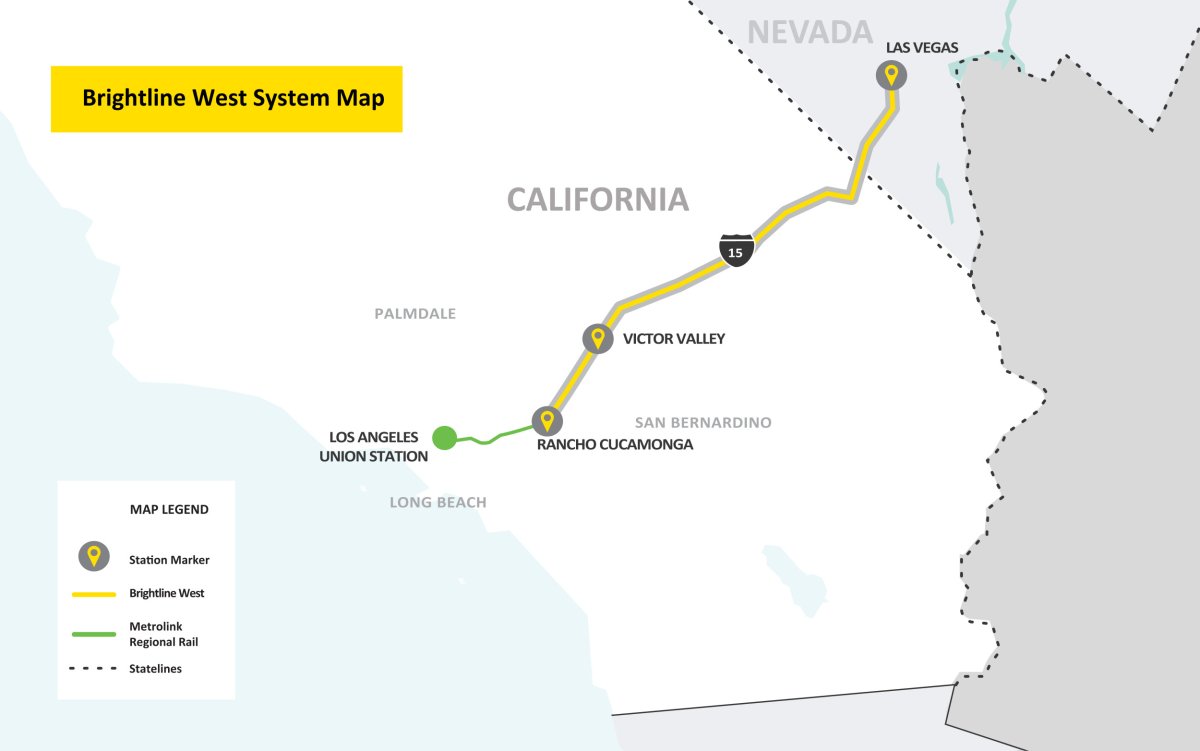Brightline West is a new all-electric, 218-mile rail line traversing two states and a map shared by the rail line shows its route between two major cities in the U.S. southwest.
Brightline West is America's "first true high-speed passenger rail system," according to the rail line's website, and will transport riders between Las Vegas and southern California. Officials broke ground on the project on Monday. Construction was originally anticipated to begin in 2020, according to a report by Fox 11, but was delayed after the company postponed a $2.4 billion bond sale needed to finance it.
According to a map of the rail line, trains will travel from Rancho Cucamonga, California, to Las Vegas, Nevada, and there will be a station in Victor Valley, California. A Metrolink regional rail train has a route from Los Angeles to Rancho Cucamonga, extending access to even more customers in southern California.

Metrolink also connects the new rail line to several other stations in Riverside, Orange, San Diego and Ventura counties, Fox 11 reported.
"Today, nearly 50 million annual trips occur between Los Angeles and Las Vegas–over 85% of them by car–a trip which is unpredictable, unreliable and challenged by congestion," the company said on its website. "Brightline West expects to serve more than 11 million one-way passengers annually."
Newsweek reached out to Brightline West by email for comment.
Each trip could transport 500 passengers, Fox 11 reported. Construction is anticipated to be complete by summer 2028, before the Olympics, which will take place in Los Angeles in that year.
According to the company, Brightline trains are all-electric, with zero emissions and are "equipped with state-of-the-art amenities." Trains can travel at up to 200 miles per hour, and the trip from Las Vegas to Cucamonga is expected to take roughly 2 hours and 10 minutes, twice as fast as the same journey by car.
In addition to improving travel options for motorists, environmental benefits are touted as well, with trains to be powered largely by emission-free sources. Existing wildlife crossings will be maintained or improved and it is anticipated that there will be a reduction in vehicle miles traveled of 700,000 miles per year, removing 400,000 tons of carbon dioxide per year and supporting both California and Nevada climate strategies.
The U.S. Environmental Protection Agency suggests that Americans can reduce their impact on climate change by traveling greener, such as by biking, walking, carpooling or using public transportation, all of which "significantly" reduce greenhouse gas emissions.
Uncommon Knowledge
Newsweek is committed to challenging conventional wisdom and finding connections in the search for common ground.
Newsweek is committed to challenging conventional wisdom and finding connections in the search for common ground.
About the writer
Anna Skinner is a Newsweek senior reporter based in Indianapolis. Her focus is reporting on the climate, environment and weather ... Read more
To read how Newsweek uses AI as a newsroom tool, Click here.






